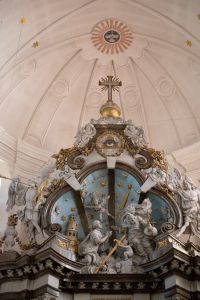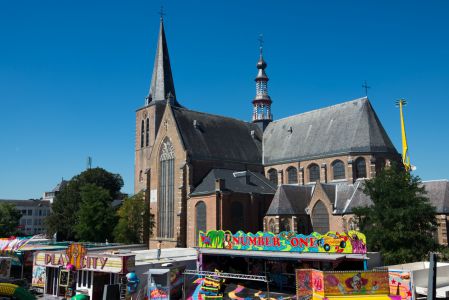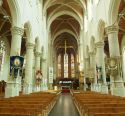Collegiate Church | XV-XVIII | Gothic | Catholic Church





Map
Opening hours
01 January - 31 December
Mon -
Tue 8.30 - 17.00
Wed 8.30 - 17.00
Thu 8.30 - 17.00
Fri 8.30 - 17.00
Sat 8.30 - 17.00
Sun 8.30 - 17.00
Guided tour
Toerisme Turnhout : +32 14 44 33 55
Religious offices
Sunday and church holidays : 10 am
Description
Throughout history, the St. Peter’s church has undergone several major renovations. Nevertheless, the church radiates a uniform austerity and dignity both inside and out.
The oldest part of the church is situated in the base of the western tower and dates from the end of the 13th century. This old church became in 1398 a collegiate church which means that it became a holding place for a chapter of 12 and later 13 canons until the French Revolution.
The current gothic ambulatory with 5 apse chapels and the transept were built in the middle of the 15th century. The lantern tower was then added in the 17th century following the plans of Geerits Lieffmans. The tower encompasses the Angelus or chapter bell that used to call local residents on regular times to prayer.
The current face of the church was mainly determined by the extensive rebuilding campaign led by architect J.P. van Baurscheit during the beginning of the 18th century in which the nave and the choir were heightened and the aisles were added.
Church decorations didn’t just serve as embellishment to the building, but were also a visual declaration of the gospel in times that most people couldn’t read. Many of these original sculpture decorations were destroyed during the iconoclasm of August, 23 1566. Most of the works of art in this church are therefore subsequent to this period. Important works of art in this church are among others the high altar, a 16th century triptych in the apse chapel, the wooden pulpit and the gorgeous 17th century pipe organ by the famous Gent organ builder Jean Le Royer.
The well taken care of collegiate church of Saint Peter in Turnhout is an oasis of serenity situated in the heart of the town, a place that because of its atmosphere and beauty makes many people fall silent.
KIKIRPA : Photo-library online
Flemish Masters in Situ
Tourism Turnhout :info guided visits
Gaudioso organises concert masses, aperitif concerts and summer concerts in the church.
Photos
Media
Remarkable elements
Main Altar
The main altar (W. Pompe) consists of two groups of statues. In the lower part: St. Peter among the sheep on the pasture; in the upper part: in a shell pattern, St. Barbara between the angels under a starry sky, in front of the creator. Above the two groups of statues is the eye of God in the center of a triangle.
Above the main altar, near the vault, is the image of the Holy Spirit (the pigeon in the middle of the rays), discovered during the last restoration work.
Choir and stalls
The choir in which the stalls are located and where the canons recited the services, was separated from the church vessel by a rood chamber. This one was removed in 1780. The stalls date from 1713.
Triptych of Saint Apollonia
The Gothic ambulatory with 5 radiant chapels features several statues and works of art. In the third chapel behind the altar, enclosed by a wrought iron gate of Pompe, is the 16th century triptych: the martyrdom of Saint Apollonia (middle and left panels) and other saints (right panel). In front of the painting is a polychrome Ecce Homo from the late 15th-early 16th century: Christ on the cold stone.
Pulpit
The central nave is dominated by the wooden pulpitof the Turnhout sculptor Peeters-Divoort (1862), inspired by the truth chair of the Saint-Andrew church in Antwerp.
It represents the moment when Jesus invites the fishermen Peter and Andrew to no longer catch fish but men. The boat full of fish and the nets are at the foot of a rock, symbol of Saint Peter. The canopy above the tank is overhung by the Holy Spirit as "inspirer" of the preacher and by angels announcing the Good News with trumpets.
Organ
Behind, on the rood pole, are the wonderful organ of the famous Ghent organ builder Jean Le Royer. The sculptures in the buffet are by Antwerp sculptor Michel Catelon.
During the summer months, organ concerts are regularly organised on the initiative of the non-profit organisation Octave, attracting Belgian and foreign listeners.
Works of art in the side aisles
See also: the confessionals of J.P. van Baurscheit; the paintings of St. Clare and St. Francis by David Teniers; the enclosure of the Chapel of the Dead at the Field of Honour (18th century); the altar of Our Lady and that of the Blessed Sacrament in 1771; the wonderful stained glass windows.























